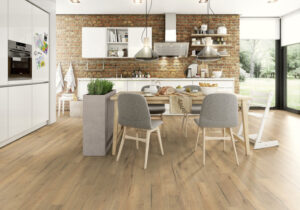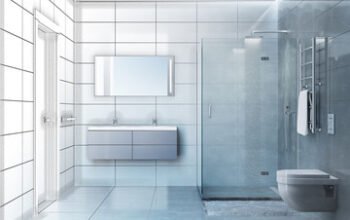What is Laminate Flooring? Laminate Flooring is a type of multi-layer synthetic flooring that is fused together through a process known as lamination. The outer layers of the flooring simulate wood by combining a photographic applique layer and a clear protective layer. The interior core layer is usually composed of fiber board materials and melamine resin. The floor then appears as a single, seamless layer, providing an aesthetic look. The interior core layer is usually waterproof and made of high-quality melamine resin.

A durable wear layer covers the wood-based base layer of the floor. This wear layer prevents scratches and dents and protects the decorative paper layer from the sun’s ultraviolet rays. Long-term exposure to the sun can cause photodegradation, which breaks down the chemical bonds that give the color. Exposure to sunlight will fade the color of your laminate floor. To avoid this, make sure to choose a floor that has a higher rating.
When installing laminate flooring, make sure to purchase the right tools for the job. Manufacturers often provide installation kits for their products. A taping block is especially useful for laminate flooring installation, as it protects the edges from being damaged when hammered. You can also purchase laminate flooring that is made of different thicknesses, so you can choose the perfect fit for your needs. If you’re replacing an entire floor, laminate flooring will be the best option.
The cost of laminate flooring is typically less than half the price of wood floors. However, the quality varies. Some laminates look more realistic than others, while others are more affordable but wear out much sooner. However, the price of laminate flooring depends on the number of square feet you wish to install, the type of flooring, and other factors. However, you can find laminate flooring at a low cost of about $26 per square meter, while solid hardwood floors can cost $50 to $150 per square meter.
Laminate flooring is made from multiple layers, including a photo layer that gives it a realistic appearance. The photographic layer is made of several sheets of paper sandwiched between two layers of melamine resin. It is designed to mimic the look of stone, wood, or tile. Many laminates feature a high-resolution photograph of wood grain that is carved and segmented according to the size of the laminate plank. The top layer provides durability and stability to the laminate floor.
The cost of laminate flooring can be very low compared to real wood, which is why it is a popular option for high-traffic areas. Its water resistance makes it an economical alternative to real wood, and the cost of laminate flooring is much lower than that of real wood. And because it is much cheaper, it is also popular in rental homes. So, while there are several advantages of laminate flooring over real wood, it’s worth checking the cost and considering your own preferences.
Another benefit of laminate flooring is its ease of installation. It’s relatively easy to install and doesn’t require glue or nails. The most important thing to remember when installing it is to avoid damaging the edges of the flooring, as this could result in water seeping. If you want to get the full warranty, you’ll need to hire a professional. The only downside to this is that it can be difficult to clean the surface. In some cases, however, laminate flooring can be very difficult to remove.
However, you should be aware of the disadvantages of laminate flooring. While laminate is generally less expensive than wood, it doesn’t look as nice. However, it’s also much easier to maintain than wood. Laminate flooring can look like real wood, and high-definition printers make it possible to replicate the look of expensive woods. Moreover, this type of flooring is not waterproof. It can be damaged when soaked in water, and it is important to protect the surface by adding a vapor barrier under it.
There are many ways to install laminate flooring. Floating floors rest above a subfloor, giving them more bounce. However, they may feel hollow as they don’t rest directly on it. Floating floors may also be easier to install than other types of flooring. The best way to install your new floor is by taking a look at a few tips and hints to make it easier to fit it. And don’t forget to consider the pros and cons of each style.


